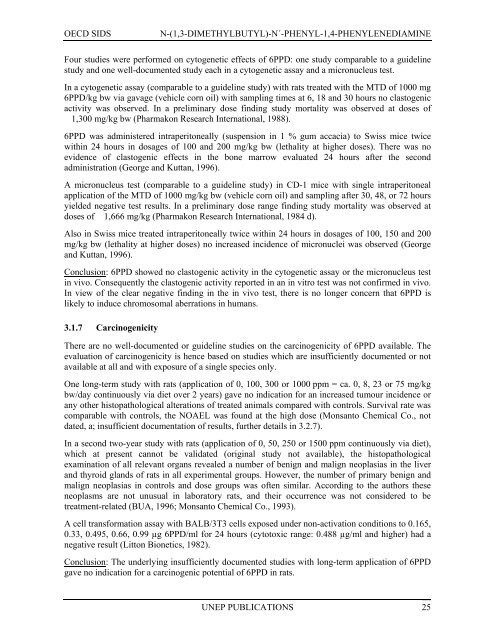N-(1,3-Dimethylbutyl)-N
N-(1,3-Dimethylbutyl)-N
N-(1,3-Dimethylbutyl)-N
Create successful ePaper yourself
Turn your PDF publications into a flip-book with our unique Google optimized e-Paper software.
OECD SIDS<br />
N-(1,3-DIMETHYLBUTYL)-N´-PHENYL-1,4-PHENYLENEDIAMINE<br />
Four studies were performed on cytogenetic effects of 6PPD: one study comparable to a guideline<br />
study and one well-documented study each in a cytogenetic assay and a micronucleus test.<br />
In a cytogenetic assay (comparable to a guideline study) with rats treated with the MTD of 1000 mg<br />
6PPD/kg bw via gavage (vehicle corn oil) with sampling times at 6, 18 and 30 hours no clastogenic<br />
activity was observed. In a preliminary dose finding study mortality was observed at doses of<br />
1,300 mg/kg bw (Pharmakon Research International, 1988).<br />
6PPD was administered intraperitoneally (suspension in 1 % gum accacia) to Swiss mice twice<br />
within 24 hours in dosages of 100 and 200 mg/kg bw (lethality at higher doses). There was no<br />
evidence of clastogenic effects in the bone marrow evaluated 24 hours after the second<br />
administration (George and Kuttan, 1996).<br />
A micronucleus test (comparable to a guideline study) in CD-1 mice with single intraperitoneal<br />
application of the MTD of 1000 mg/kg bw (vehicle corn oil) and sampling after 30, 48, or 72 hours<br />
yielded negative test results. In a preliminary dose range finding study mortality was observed at<br />
doses of 1,666 mg/kg (Pharmakon Research International, 1984 d).<br />
Also in Swiss mice treated intraperitoneally twice within 24 hours in dosages of 100, 150 and 200<br />
mg/kg bw (lethality at higher doses) no increased incidence of micronuclei was observed (George<br />
and Kuttan, 1996).<br />
Conclusion: 6PPD showed no clastogenic activity in the cytogenetic assay or the micronucleus test<br />
in vivo. Consequently the clastogenic activity reported in an in vitro test was not confirmed in vivo.<br />
In view of the clear negative finding in the in vivo test, there is no longer concern that 6PPD is<br />
likely to induce chromosomal aberrations in humans.<br />
3.1.7 Carcinogenicity<br />
There are no well-documented or guideline studies on the carcinogenicity of 6PPD available. The<br />
evaluation of carcinogenicity is hence based on studies which are insufficiently documented or not<br />
available at all and with exposure of a single species only.<br />
One long-term study with rats (application of 0, 100, 300 or 1000 ppm = ca. 0, 8, 23 or 75 mg/kg<br />
bw/day continuously via diet over 2 years) gave no indication for an increased tumour incidence or<br />
any other histopathological alterations of treated animals compared with controls. Survival rate was<br />
comparable with controls, the NOAEL was found at the high dose (Monsanto Chemical Co., not<br />
dated, a; insufficient documentation of results, further details in 3.2.7).<br />
In a second two-year study with rats (application of 0, 50, 250 or 1500 ppm continuously via diet),<br />
which at present cannot be validated (original study not available), the histopathological<br />
examination of all relevant organs revealed a number of benign and malign neoplasias in the liver<br />
and thyroid glands of rats in all experimental groups. However, the number of primary benign and<br />
malign neoplasias in controls and dose groups was often similar. According to the authors these<br />
neoplasms are not unusual in laboratory rats, and their occurrence was not considered to be<br />
treatment-related (BUA, 1996; Monsanto Chemical Co., 1993).<br />
A cell transformation assay with BALB/3T3 cells exposed under non-activation conditions to 0.165,<br />
0.33, 0.495, 0.66, 0.99 µg 6PPD/ml for 24 hours (cytotoxic range: 0.488 µg/ml and higher) had a<br />
negative result (Litton Bionetics, 1982).<br />
Conclusion: The underlying insufficiently documented studies with long-term application of 6PPD<br />
gave no indication for a carcinogenic potential of 6PPD in rats.<br />
UNEP PUBLICATIONS 25
















